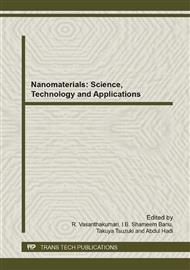p.52
p.58
p.63
p.71
p.76
p.85
p.91
p.97
p.103
Synthesis of Silicon Nanostructures Using DC-Arc Thermal Plasma: Effect of Ambient Hydrogen on Morphology
Abstract:
Silicon nanoparticles (Si-NPs) were synthesized using thermal plasma assisted gas phase condensation at different compositions of argon and hydrogen. The content of hydrogen in argon was varied from 0 to 15 mole percent. Synthesized nanoparticles were characterized by Transmission Electron Microscopy (TEM) and Fourier Transform Infrared spectroscopy (FTIR). Noticeable change in the morphology of nanostructures was observed with changing hydrogen content. Si-NPs synthesized in the presence of argon consisted of flake like structures, mostly amorphous. With increase in hydrogen concentration, flake like structures disappeared and prominent spherical structures and nanowires were observed. On further increasing hydrogen content spherical crystalline nanostructures with a tail of nanowire were formed and then nanoplatelets of SiC along with silicon nanostructures were observed. Different parameters that changed owing to different hydrogen concentration, were calculated and it is attempted to predict the cause of changing morphology.
Info:
Periodical:
Pages:
76-81
Citation:
Online since:
June 2014
Authors:
Keywords:
Price:
Сopyright:
© 2014 Trans Tech Publications Ltd. All Rights Reserved
Share:
Citation:


